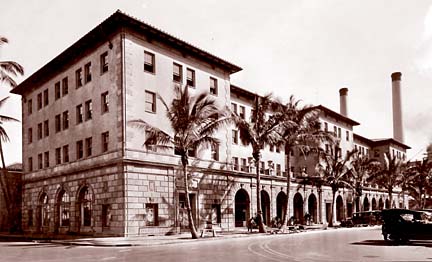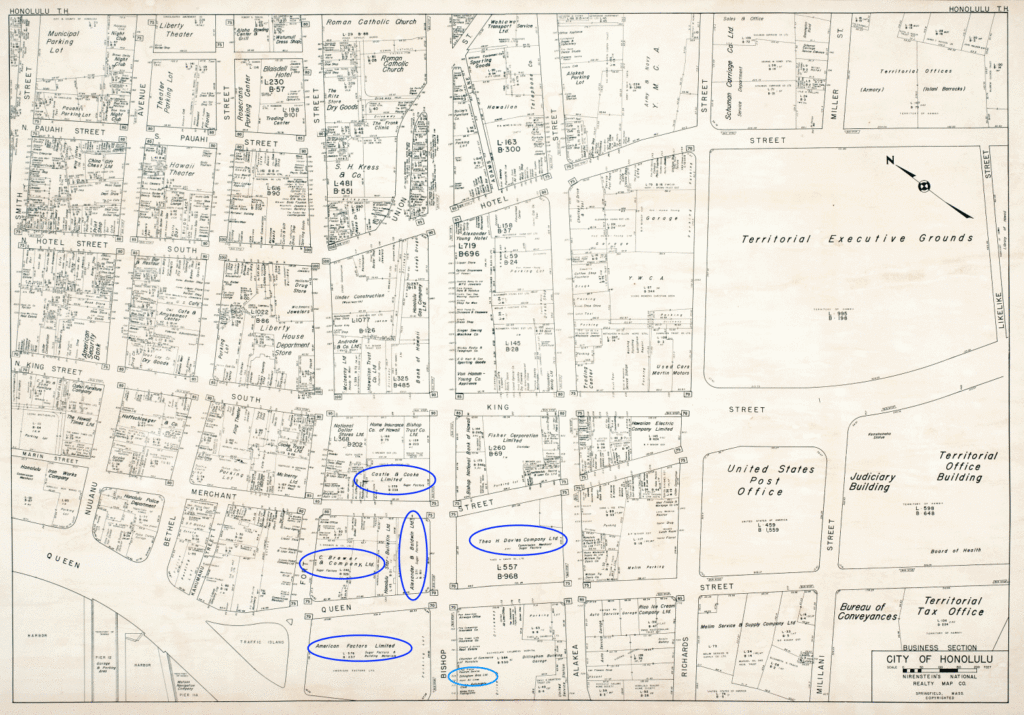Opera was born circa 1600 from the desire of Renaissance Italians to recreate Greek drama, pointing to various less-elevated national theatrical traditions as important contributors to the art form. (Abbate)
Although Hawai‘i is hardly known as an international opera powerhouse, a number of native Hawaiians have been among the art form’s stars. Most notable was tenor Tandy Ka‘ohu MacKenzie, who was born in Hāna in 1892 and went on to become a star of the international opera stage star after he was discovered by an Irish singer who happened to drop in on a performance by MacKenzie’s Kamehameha School glee club. (Ferrar)
In 1881, a Music Hall was built across the street from ʻIolani Palace, where Ali‘i regularly joined the audiences at performances. Queen Lili‘uokalani is even said to have written her own opera. (Ferrar) It was built by the Hawaiian Music Hall Association.
The Wells troupe from California opened the music hall. “Since then many companies and individual artists from abroad have trod its boards, and given more or less delight to the inhabitants.” (Daily Bulletin, February 12, 1895)
The building was first called the Music Hall, but shortly after its transfer to new owners, the name was changed to the Royal Hawaiian Opera House. (Daily Bulletin, February 12, 1895)
Despite its name, the Opera House was not primarily a venue for classical entertainment. Many of its bookings were melodramas and minstrel shows, two very popular forms of theater at the time. Then, it was the first house to show moving pictures in Hawaiʻi.
The building was of brick 120 by 60 feet on the ground floor and walls forty feet high and twenty inches thick. The front door was ten feet wide, opening into a vestibule 16 by 27 feet. The seating capacity of the house was 671 persons. The stage was forty feet deep and provided with a complete set of scenery, traps and all necessary paraphernalia. (Hawaiian Star, February 12, 1895)
On July 28, 1883, the property was sold at auction to satisfy a claim. It was purchased by Mr. WG Irwin for $21,000, John D Spreckels being a partner in the deal. (Hawaiian Star, February 12, 1895)
“Originally there were two (private) boxes. One on the right of the stage looking out was regarded as the property of the late King Kalākaua, who had subscribed liberally to the stock of the Association. The box on the opposite side was owned by the present proprietors, Messrs. Irwin & Spreckels. About two years ago two boxes wore opened above those mentioned for letting to whomever first applied for thorn on any occasion.” (Daily Bulletin, February 12, 1895)
The Music Hall played a role in the Wilcox Rebellion, when it was occupied by Government sharpshooters in suppressing the insurrection of Robert Wilcox in 1889. (Daily Bulletin, February 12, 1895)
“Wilcox and I then marched towards the gate and came by Boyd’s cannon; he told us to get out of the way he wanted to fire then, because he saw some one in the Music Hall pulling down a window; Wilcox stopped him; we walked on toward the gate when a gun fired from the Music Hall.” (Kauhane, Hawaiian Gazette, October 29, 1889)
“Wilcox sung out to Music Hall to “stop firing! stop firing!” three or four more shots were fired from there and then Wilcox gave order to fire; cannons were then fired; think Wilcox knew that Government were gathering forces to drive us out; not my place to surrender.” (Kauhane, Hawaiian Gazette, October 29, 1889)
It later hosted the complimentary farewell reception and ball for Captain Wiltse, commander of the USS Boston in 1893, under the auspices of the provisional Government.
The Music Hall’s “exterior was built of red brick and the facade on King street was of a modest but presentable and harmonious style. Internally it was fitted and furnished in modern fashion, with seats on a sloping floor in semi-circular rows. There were a balcony and a gallery in the second story.” (Daily Bulletin, February 12, 1895)
Fire nearly destroyed the building. Irwin, owner of the property, surveyed the sodden, smoking ashes from his curtained carriage. “I have had enough of music halls,” he told a questioning newsman.
He was later persuaded to rebuild, however, when it was pointed out that the only other theatrical accommodations in the city were inadequate facilities at the YMCA and the hall in Independence Park.
A commission was appointed to inquire into the strength of the walls left standing. After a careful inspection, it was decided that three of the walls were in sound condition, and could be built upon with perfect safety. The rear wall had to be rebuilt. The work began.
The opening of the New Hawaiian Opera House tonight begins another epoch in the history of Honolulu and the public finds that through the action of William G. Irwin of this city and John D. and Adolph Spreckels, of San Francisco, it has a theater equal to the leading places of amusement in the United States. (Hawaiian Gazette, November 10, 1896)
A commission was appointed to inquire into the strength of the walls left standing. After a careful inspection, it was decided that three of the walls were in sound condition, and could be built upon with perfect safety. The rear wall had to be rebuilt. The work began.
The seating capacity of the New Hawaiian was about 900, but the seats were placed so far apart, in order to make it more comfortable for the patrons, that if it were necessary, two or three hundred more chairs could be placed in the auditorium without crowding. In the rear of the orchestra are two loges, each containing six chairs. (Hawaiian Gazette, November 10, 1896)
On February 5, 1897, the Opera House displayed Edison’s Veriscope which promised to be one of the most interesting sights ever seen in Honolulu. One of the first projections was of a fire department response to a fire. “The crowds gather, people run hither and thither, teams pass, some block the way, the police appear, and there are seen all the usual incidents of a street lire drill.”
“It is a wonderful advance in the stereoscopic art. It projects pictures upon a white screen, in which all the figures are in motion with life-like detail. … The exhibition of the wonderful veriscope is alone worth the evening’s attendance.” (Hawaiian Star, February 4, 1897)
The building was demolished in 1917 to make way for the Federal Building. One of the many eulogies for the building said: “It is historical. It is ugly. It is like a box with a few touches of ornament to make it look unlike a box. So much for the outside. On the inside, it is as cozy and comfortable as anyone could desire.” (Gereben)

































































